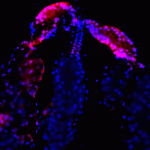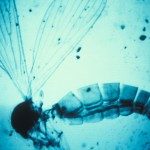Lien vers Pubmed [PMID] – 28539440
Lien DOI – e00571-1710.1128/JVI.00571-17
J Virol 2017 Aug; 91(15):
Endogenous viral elements derived from nonretroviral RNA viruses have been described in various animal genomes. Whether they have a biological function, such as host immune protection against related viruses, is a field of intense study. Here, we investigated the repertoire of endogenous flaviviral elements (EFVEs) in Aedes mosquitoes, the vectors of arboviruses such as dengue and chikungunya viruses. Previous studies identified three EFVEs from Aedes albopictus cell lines and one from Aedes aegypti cell lines. However, an in-depth characterization of EFVEs in wild-type mosquito populations and individual mosquitoes in vivo has not been performed. We detected the full-length DNA sequence of the previously described EFVEs and their respective transcripts in several A. albopictus and A. aegypti populations from geographically distinct areas. However, EFVE-derived proteins were not detected by mass spectrometry. Using deep sequencing, we detected the production of PIWI-interacting RNA-like small RNAs, in an antisense orientation, targeting the EFVEs and their flanking regions in vivo The EFVEs were integrated in repetitive regions of the mosquito genomes, and their flanking sequences varied among mosquito populations. We bioinformatically predicted several new EFVEs from a Vietnamese A. albopictus population and observed variation in the occurrence of those elements among mosquitoes. Phylogenetic analysis of an A. aegypti EFVE suggested that it integrated prior to the global expansion of the species and subsequently diverged among and within populations. The findings of this study together reveal the substantial structural and nucleotide diversity of flaviviral integrations in Aedes genomes. Unraveling this diversity will help to elucidate the potential biological function of these EFVEs.IMPORTANCE Endogenous viral elements (EVEs) are whole or partial viral sequences integrated in host genomes. Interestingly, some EVEs have important functions for host fitness and antiviral defense. Because mosquitoes also have EVEs in their genomes, characterizing these EVEs is a prerequisite for their potential use to manipulate the mosquito antiviral response. In the study described here, we focused on EVEs related to the Flavivirus genus, to which dengue and Zika viruses belong, in individual Aedes mosquitoes from geographically distinct areas. We show the existence in vivo of flaviviral EVEs previously identified in mosquito cell lines, and we detected new ones. We show that EVEs have evolved differently in each mosquito population. They produce transcripts and small RNAs but not proteins, suggesting a function at the RNA level. Our study uncovers the diverse repertoire of flaviviral EVEs in Aedes mosquito populations and contributes to an understanding of their role in the host antiviral system.



